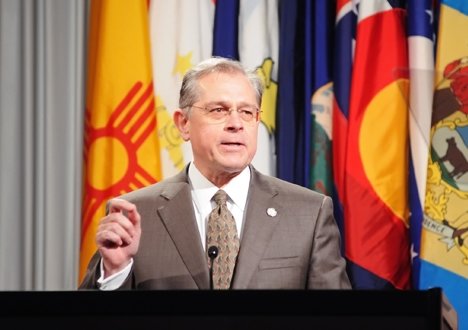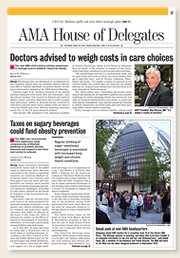AMA House of Delegates

"We can and will change the world for America's patients and physicians -- for the better -- under physician leadership," says AMA's Dr. Madara. Photos by Ted Grudzinski / AMA
CEO spells out AMA's strategic direction at Annual Meeting
■ Also at the policymaking gathering, Denver psychiatrist Jeremy A. Lazarus, MD, is inaugurated AMA president.
By Damon Adams — Posted July 2, 2012

- ANNUAL MEETING 2012
- » Our coverage
- » Print special section
- » AMA official proceedings
- » Related content
Chicago American Medical Association Executive Vice President and CEO James L. Madara, MD, presented the AMA’s strategic plan to the House of Delegates at the Association’s Annual Meeting. The plan focuses on three areas: improving health outcomes; accelerating change in medical education; and improving physician satisfaction by shaping payment and delivery models.
The AMA’s efforts will seek to demonstrate improvements in clinical and patient-reported outcomes, ensure health equity, and advance the safety and quality of health care, among other efforts, Dr. Madara said. To reach these goals, the Association will identify a focused set of outcomes, starting with two or three this year, and then expand the list. Impacting health outcomes can lead to greater patient satisfaction and reduce health care costs, he said.
The AMA also will work to reshape medical education to better align physician training with the needs of the health care system. That will include forming partnerships that create new methods of medical education. Attention will be focused on flexibility in medical education, such as allowing select students to reduce their education debt by combining the fourth year of training with the first year of residency.
The strategic plan calls for the AMA to establish partnerships with individual doctors, integrated physician organizations and others to identify effective delivery models that provide both quality patient care and doctor satisfaction. The AMA will share this information to help physicians implement changes in their practices.
“No other organization has done more to shape health and health care in this country than our AMA,” Dr. Madara told more than 450 delegates gathered at the Hyatt Regency Chicago. “This is familiar territory to us. We know our AMA can do it. Working together, we can and will change the world for America’s patients and physicians — for the better — under physician leadership. That’s the plan. That’s our future.”
Dr. Madara stressed that the AMA is committed to strengthening all areas of the what was described at the meeting as the “AMA Equation”: the House of Delegates; individual members; practice management tools; research and education; and advocacy.

Dr. Hoven
During the Annual Meeting, Ardis Dee Hoven, MD, an internal medicine and infectious diseases specialist in Lexington, Ky., was named AMA president-elect. Dr. Hoven will serve as president after Denver psychiatrist Jeremy A. Lazarus, MD, who was inaugurated AMA president on June 19 and will serve one year.
Lexington, Ky., emergency medicine physician Steven J. Stack, MD, is the new chair of the AMA Board of Trustees. David O. Barbe, MD, MHA, a family physician from Mountain Grove, Mo., was named chair-elect. Stephen R. Permut, MD, JD, a family physician from Wilmington, Del., was named secretary.
Hollidaysburg, Pa., orthopedic surgeon Andrew W. Gurman, MD, was re-elected house speaker. Susan R. Bailey, MD, an allergist, immunologist and pediatrician from Fort Worth, Texas, was re-elected vice speaker.
New members to the Board of Trustees are: William E. Kobler, MD, a family physician from Rockford, Ill.; Malini P. Daniel, a medical student at the Stanford School of Medicine in Palo Alto, Calif.; and Julie K. Goonewardene, associate vice chancellor for innovation and entrepreneurship for the University of Kansas in Lawrence.












